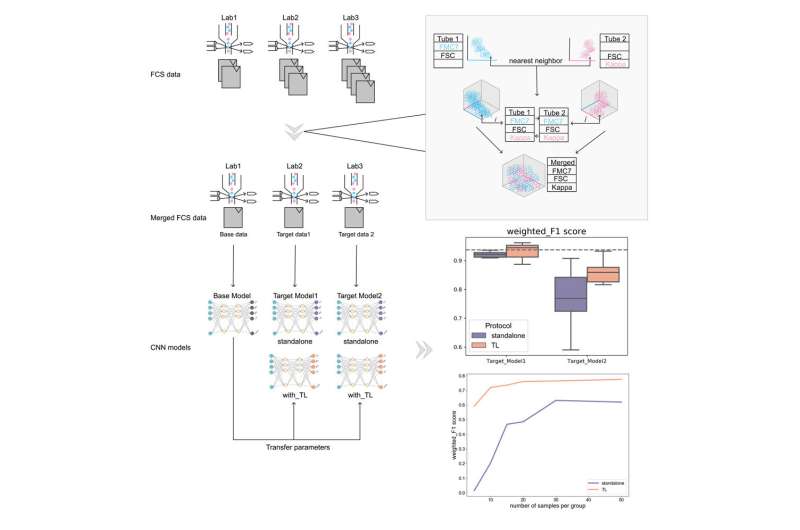Home » Health News »
Artificial intelligence helps diagnose leukemia

The presence of cancer of the lymphatic system is often determined by analyzing samples from the blood or bone marrow. A team led by Prof. Dr. Peter Krawitz from the University of Bonn had already shown in 2020 that artificial intelligence can help with the diagnosis of such lymphomas and leukemias. The technology fully uses the potential of all measurement values and increases the speed as well as the objectivity of the analyses compared to established processes. The method has now been further developed so that even smaller laboratories can benefit from this freely accessible machine learning method—an important step towards clinical practice. The study has now been published in the journal Patterns.
Lymph nodes become swollen, there is weight loss and fatigue, as well as fevers and infections—these are typical symptoms of malignant B-cell lymphomas and related leukemias. If such a cancer of the lymphatic system is suspected, the physician takes a blood or bone marrow sample and sends it to specialized laboratories. This is where flow cytometry comes in. Flow cytometry is a method in which the blood cells flow past measurement sensors at high speed. The properties of the cells can be detected depending on their shape, structure or coloring. Detection and accurate characterization of pathological cells is important when making a diagnosis.
The laboratories use “antibodies” that dock to the surface of the cells and are coupled to fluorescent dyes. Such markers can also be used to detect small differences between cancer cells and healthy blood cells. Flow cytometry generates large amounts of data. On average, more than 50,000 cells are measured per sample. These data are then typically analyzed on screen by plotting the expression of the markers used against each other. “But with 20 markers, the doctor would already have to compare about 150 two-dimensional images,” says Prof. Dr. Peter Krawitz of the Institute for Genomic Statistics and Bioinformatics at the University Hospital Bonn. “That’s why it’s usually too costly to thoroughly sift through the entire data set.”
For this reason, Krawitz, together with the bioinformaticians Nanditha Mallesh and Max Zhao, investigated how artificial intelligence can be used to analyze cytometry data. The team considered more than 30,000 data sets from patients with B-cell lymphoma to train artificial intelligence (AI). “AI takes full advantage of the data and increases the speed and objectivity of diagnoses,” says lead author Nanditha Mallesh. The result of the AI evaluations is a suggested diagnosis that still needs to be verified by the physician. In the process, the AI provides indications of conspicuous cells.
Specialists reviewed the results of artificial intelligence
Blood samples and cytometer data were obtained from the Munich Leukemia Laboratory (MLL), the Charité – Universitätsmedizin Berlin, the University Hospital Erlangen and the Bonn University Hospital. Specialists from these institutions examined the results of artificial intelligence. “The gold standard is diagnosis by hematologists, which can also take into account results of additional tests,” Krawitz says. “The point of using AI is not to replace physicians, but to make the best use of the information contained in the data.” The great new feature of the AI now presented lies in the possibility of knowledge transfer: Particularly smaller laboratories that cannot afford their own bioinformatics expertise and may also have too few samples to develop their own AI from scratch can benefit from this. After a short training phase, during which the AI learns the specifics of the new laboratory, it can then draw on knowledge derived from many thousands of data sets.
All raw data and the complete software are open source and therefore freely accessible. In addition, res mechanica GmbH, which was involved in the study, has developed a web service that makes artificial intelligence usable even for users without bioinformatics expertise. “With hema.to, we want to enable the exchange of anonymized flow cytometry data between laboratories and in this way create the conditions for even higher quality in diagnostics,” says Dr. Hannes Lüling of res mechanica.
Source: Read Full Article

